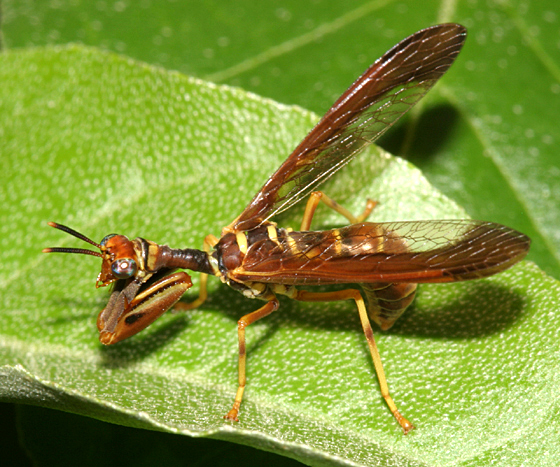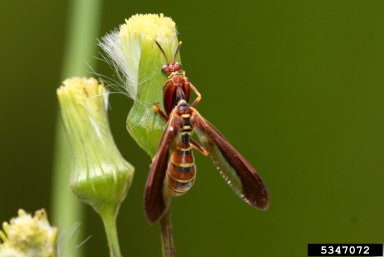
Habitat
Climaciella brunnea Larvae
 The
C. brunnea larvae are spider-egg predators (Redborg et.
al 2000). The adult C. brunnea come in from the fields where they live and lay
their eggs on the forest floor or low laying plants. When the eggs hatch the larvae
attract a spider by standing upright and swaying back and forth
(Batra 1972). When the spider comes near they then climb aboard
the spider and wait until it lay its eggs. The larvae then enter
the spider's egg sack while it is being constructed. The spider
could be the host for a long to short period of time. The larvae
will even overwinter on the spiders back if it is necessary
while waiting until the spider constructs its egg sack. If the
larvae board a male spider the larvae will wait until copulation and
then transfer over to the female spiders back (Guarisco 1998).
Once inside the sealed egg sack the larvae will eat the eggs and
then spin its own cocoon where it develops into a pupa (Hoffman
et. al 1992).
The
C. brunnea larvae are spider-egg predators (Redborg et.
al 2000). The adult C. brunnea come in from the fields where they live and lay
their eggs on the forest floor or low laying plants. When the eggs hatch the larvae
attract a spider by standing upright and swaying back and forth
(Batra 1972). When the spider comes near they then climb aboard
the spider and wait until it lay its eggs. The larvae then enter
the spider's egg sack while it is being constructed. The spider
could be the host for a long to short period of time. The larvae
will even overwinter on the spiders back if it is necessary
while waiting until the spider constructs its egg sack. If the
larvae board a male spider the larvae will wait until copulation and
then transfer over to the female spiders back (Guarisco 1998).
Once inside the sealed egg sack the larvae will eat the eggs and
then spin its own cocoon where it develops into a pupa (Hoffman
et. al 1992).

Climaciella brunnea Mature Adult
The adult C. brunnea live in fields on flowers of thistle and
other plants. They live in regions all over ranging from southern Canada,
to the central and western regions of the United States, Mexico,
and Central America. The adult C. brunnea prefer the plants
where the soil is moist as opposed to the plants that live
in dryer regions (Batra 1972). Below is a link of where the C. brunnea
are found throughout North America, the link states that it may
not represent the entire distribution, but it gives a good idea
of where they can be found.
http://eol.org/pages/418523/maps
Below is another link of which states the C. brunnea
are found in.
http://www.insectidentification.org/insect-description.asp?identification=Brown-Mantidfly
